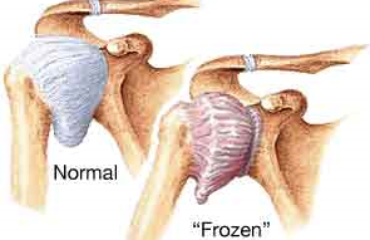Biceps tears are the most common type of injury that leads to pain in bicep muscles and loss of functionality. It mostly occurs in middle-aged people and more specifically those participating in weightlifting, contact sports, throwing sports, or martial arts. Treatment options for biceps tears recognize their dissimilarity from tendonitis, impingement, and tendon dislocations that also affect bicep muscles and address accordingly.
What is a biceps tear?
When tendons in the biceps muscles are torn away from the elbow or shoulder bone, it is called biceps tears. Due to recurrent stress, injury, twisting of bicep muscles, heavy lifting, or continuous overuse, tendons may fray and tear.
Biceps tears can be partial or complete. Partial tears are small soft tissue tears leading to limited detachment off tendon from bones while complete ones occur when a tendon is torn away or gets completely detached from the elbow or shoulder bone.
Biceps tears at shoulder are common. Such tears at elbow end are sporadic.
How do biceps tears occur?
Biceps comprise of muscles. The tendons of these muscles connect to shoulder bone on one hand and elbow bone on the other. Most biceps tears occur progressively. A strained biceps under continued stress and trauma begins to fray. This finally causes tears to appear.
Sudden and more grievous biceps tears at elbow or shoulder may also appear as a result of accidents, falling, and high speed impact. In such a scenario, the biceps is unable to bear the stress and tendons get damaged by overbearing, unexpected amount of force.
Those above 40 years of age are at greater risk of biceps tears at shoulder level. Tears in rotator cuff muscles may also lead to biceps tears. Young athletes and those lifting heavy weights also face the increased risk of biceps tears.
What are the symptoms of biceps tears?
- Sudden pain felt in the upper arm
- Popping or snapping sound heard when biceps tear away
- Sharp pain in the biceps when used strenuously
- Visible bruising or inflammation at the elbow or middle of the upper arm
- Tenderness and weakness in biceps
- Bulges may appear near the shoulder or elbow
- Limited disability and loss of strength
- Inability to rotate the fore arm
- Muscle stiffness
What are the most common causes of biceps tears?
- Injury to arm due to accident or sports or trauma
- Over use of biceps muscles
- Weight lifting, heavy overhead activities
- Muscle or tendon weakness due to steroid intake
What are effects of biceps tears?
Biceps tears lead to localized pain and limit the range of arm movement. It may also damage the rotator cuff tendons.
How are biceps tears diagnosed?
The first stage is the physical examination of symptoms. Doctors usually test the supination ability of the forearm and analyze the result comparing with the non-injured hand. Imaging tests, such as x-ray, ultrasound, and MRI are also recommended for a thorough diagnosis.
What types of treatment options available for biceps tears?
Biceps tears don’t heal on their own. Surgery is the most accepted mode of treatment for biceps tears. However, those with limited soft tissue damage, unable to undergo surgery, or do not require full arm function may seek nonsurgical treatment options for biceps tears.
What are non-surgical treatment options available for biceps tears?
Non-surgical treatment for biceps tears are for those who are not leading an active life and don’t need much arm activity except to carry on the daily routine. It suits for those having a sedentary lifestyle, older, or with medical problems preventing surgery. These biceps tears treatment methods are limited to managing pain and muscle spasm.
Non-steroidal anti-inflammatory drugs, painkillers, and analgesic medications inhibit pain and swelling. Physical therapy is also used to increase muscle strength and range of motions. Rest, ice therapy, and avoiding certain stressful activities also help.
What are surgical treatment options available for biceps tears?
Biceps tears snap the strength of the forearm. Surgery is essential to restore it. Those leading an active life, engaged in manual labor, such as gardening and driving, daily, and have to use hand tools or working out frequently, need the surgical treatment for biceps tears. Surgery is a must for athletes and young adults depending on their biceps muscles for everyday job.
Surgical treatment of biceps tears must not be delayed. It should be performed in the first 2 to 3 weeks. Delay may lead to formation of scar tissues. Even tendons may shorten causing reintegration and the restoration or arm strength difficult.
Recovery from surgery takes about three months with restriction on certain physical activities for six weeks. Depending on the patient condition, a variety of surgical methods are used to treat biceps tears.
- Surgical reattachment is the most used treatment option for biceps tears. Anchors are used to attach the torn tendon down to the bone. Recovery takes about 6 weeks.
- Tenotomy is the most used surgical treatment option for partial biceps tears. The torn tendon is either completely released to suppress symptoms or detached and reconnected to the bone further down the arm. This may result in tightening of biceps muscles or a bulge in the upper arm with loss of some biceps strength.
- Partial biceps tears are also addressed with surgical removal of torn parts of the tendon and reattachment to the bone using special screws.
- Suture-anchor surgery is another popular option. This surgical treatment of biceps tears is minimally invasive and performed with the help of special instruments. A small incision is made at the place where biceps tendon joints the bone. The torn biceps tendon is retrieved and attached to the bone using two suture-anchors.
- Keyhole surgery involves creating a tiny hole in the bone and placing the end of the tendon inside. Anchors are used to ensure the arrangement becomes permanent. This surgical treatment of biceps tears is also known as biceps tenodesis.
- Bridge surgery is for those with biceps tears that are more than 4 weeks old. In case of delayed treatment, the torn tendons retract up the arm. An incision is made up the arm to retrieve and reconstruct it. A tendon obtained from thigh ligament is used as a bridge to reattach the torn tendon with the bone.
References
Abrams JS. Special shoulder problems in the throwing athlete: pathology, diagnosis, and nonoperative management. Clin Sports Med. 1991;10(4):839–861.
Carter AM, Erickson SM. Proximal biceps tendon rupture primarily an injury of middle age. Physician Sports Med. 1999. 27:95-102.
Green JB, Skaife TL, Leslie BM. Bilateral distal biceps tendon ruptures. J Hand Surg Am. 2012 Jan. 37(1):120-3.
Sutton KM, Dodds SD, Ahmad CS, Sethi PM. Surgical treatment of distal biceps rupture. J Am Acad Orthop Surg. 2010 Mar. 18(3):139-48.
Khan AD, Penna S, Yin Q, et al. Repair of distal biceps tendon ruptures using suture anchors through a single anterior incision. Arthroscopy. 2008 Jan. 24(1):39-45.
Fenton P, Qureshi F, Ali A, et al. Distal biceps tendon rupture: a new repair technique in 14 patients using the biotenodesis screw. Am J Sports Med. 2009 Jun 22.
Heinzelmann AD, Savoie FH 3rd, Ramsey JR, et al. A combined technique for distal biceps repair using a soft tissue button and biotenodesis interference screw. Am J Sports Med. 2009 May. 37(5):989-94.
Gregory T, Roure P, Fontes D. Repair of distal biceps tendon rupture using a suture anchor: description of a new endoscopic procedure. Am J Sports Med. 2009 Mar. 37(3):506-11.



